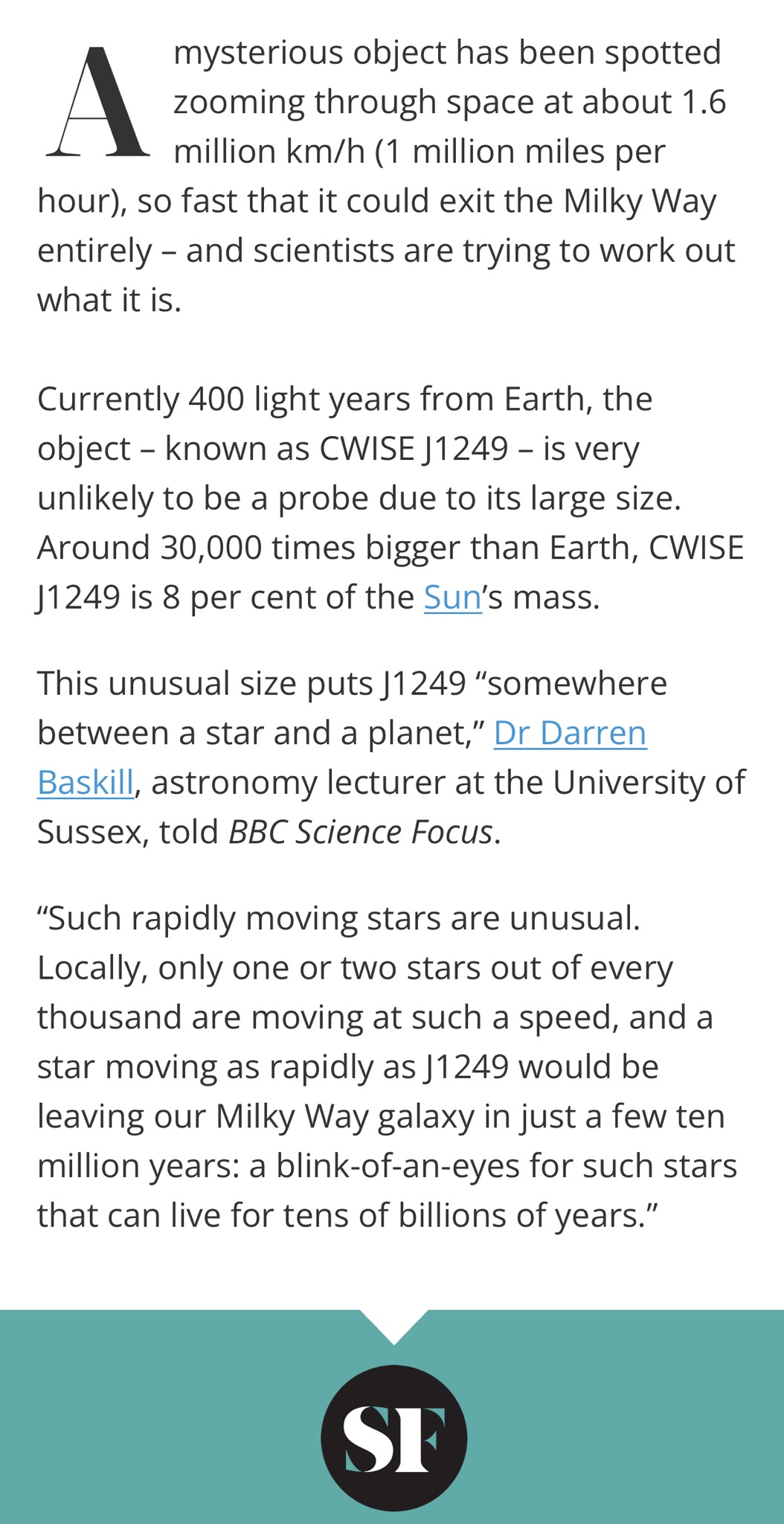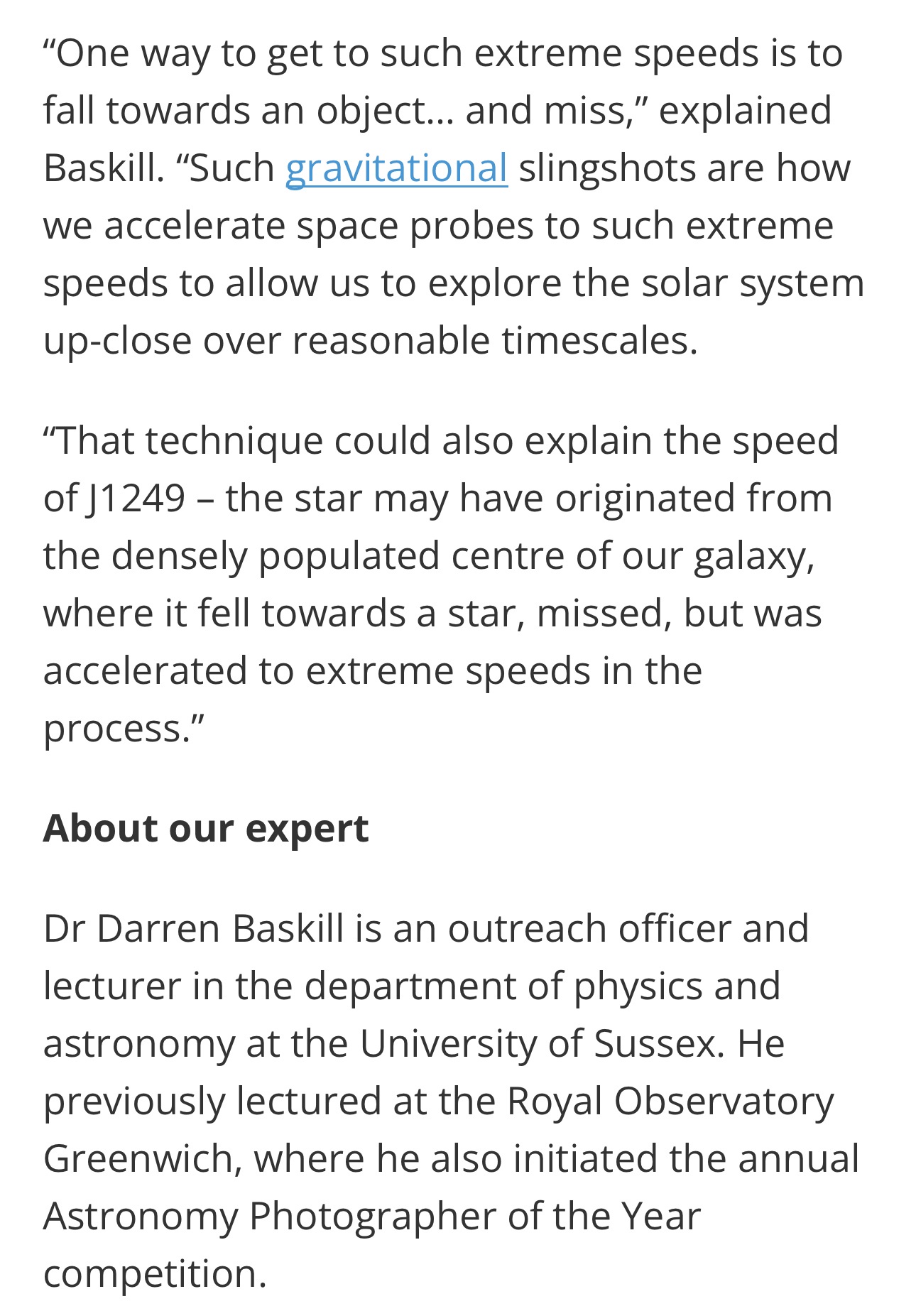DaveSamsonite
2245
80
3

This article is from Science Focus magazine. It’s not about Oumuamua.
Source: https://www.sciencefocus.com/news/mysterious-fast-object-space





Aug 22, 2024 10:25 AM
DaveSamsonite
2245
80
3

This article is from Science Focus magazine. It’s not about Oumuamua.
Source: https://www.sciencefocus.com/news/mysterious-fast-object-space





lostinamapfactory
Bet you weren't expecting this!
ParaspriteHugger
"Fall towards an object and miss"
PrastaryOrk
Uh-oh...
Flareside
It's not a big deal. It's just aliens, they speed up going through a bad neighborhood just like you do.
DaveSamsonite
They have to start hitting the brakes five star systems before them when they wanna stop it.
UnattendedDeviant
Morataya
My guess, Shlorpian terraforming gone wrong.
daverbeans
A bit of sloppy language - I suspect they likely meant mass when they said size. Anywho, a couple other things they glossed over include the composition. The first generation of stars, called population 3 stars (because astronomers name things and then never change the names) would be extremely metal poor as stars themselves es are required to produce heavier elements (anything above He (and trace Li)). Stars this low in mass would live a very long time because they consume their fuel so slowly.
DaveSamsonite
Not sloppy. They said it has 8% of our sun’s mass, so 1.58 x 10^29 kg. Pretty big.
trinxter
Good thing there is a lot of space for it to pass through. 277 miles per second is a better measurement. That is like 10 times the speed of the average meteor. And yet nowhere near the speed at which red shift is significant.
DaveSamsonite
Yes, article says 0.001% but I calculated 1 /670th of the speed of light. That’s nearly 0.15% of the speed of light. In a Science magazine I would have expected better math.
spattr
Sounds to me like Space Vikings!!
Somerandomoldguy
Basic money is on somethinh that got slingshotted by a bigger star or black hole and is now flying off for a life of adventure.
DaveSamsonite
Yes, multiple gravitational slingshots off some far more massive object. Could be a rogue planet but those would not be bright. Too small to be a star, too large to be ice I am guessing.
DaveSamsonite
Who downvoted? And why?
DWandRFaremyspiritbeings
To further on that, the object was probably a star, and the bigger star/blackhole it was in a binary-system with probably scavenged all of it's gasses, causing it to both lose enough mass to be slingshotted like you mentioned and also why it seems to be 'too small for a star but too big for a planet', as mentioned in the article.
Somerandomoldguy
After doing a little maths its basically trucking along at twice the speed we are (492000mph/220kmps) which is pretty spiffy.
DaveSamsonite
Very small star. Our sun, Sol, is a red dwarf.
Zetor
"In a just a few ten million years" Only astronomers could put together a phrase like that
Kittensandyarns
Scientists certainly have different time definitions than the average person. I once heard a geologist say, ".... this happens with the speed of lightning, it takes only 250000 years...."
trekkiedane
'This reacts extremely slow' -when talking about gunpowder is also never not funny!
ThrockmortonTheSkateboarder
Saiyans?
turbodog
"very unlikely to be a probe due to...." the Drake equation has something to say about that.
Subtilico
Maybe something went wrong with a dyson sphere.
DoveLeiger
Oh, that's just me zooming away from this election. Sorry for causing all the confusion. I should have left a note.
goodBEan
DaveSamsonite
Xenu is returning
dashcan
It hit the edge, and is heading back. S'why its going so fast.
wurstkaesescenario
Any chance of Borg?
trekkiedane
I doubt the Swedes have anything to do with this.
mrmartini
If they spotted it around 3am last night, it was probably Pascal, my cat, having the hecken zoomies. In space. Again.
DaveSamsonite
Makes sense. My long gone void kitty Samson was a transdimensional being. He could only be seen with the brightest of lights so most photos only show his eyes.
DaveSamsonite
I’m not even 100% sure this is him. I have this exact rug but so few photos of him & this one shows his bodily form in unusually clear detail. In other photos he looked like this - (This is not him, but he was fond of lying on anything black.)
Other than during his midde-of-the-night galloping in total darkness, while screeching like an MTG - he was usually lurking. In the darkest spot we had. His goal was tripping you when carrying a piece of fried chimken!
Littledirtybirdyfeet
Rama
trekkiedane
Wasn't that somewhat smaller?
Littledirtybirdyfeet
Yeah, I didn't read the article before commenting.
trekkiedane
Have to admit: I kinda guessed.
Littledirtybirdyfeet
IrrationalNumber
So likely a rogue planet that's been flinged out of the system it formed in. Mathematically very common, we just haven't spotted many.
PileOfWalthers
flung*
DaveSamsonite
The speed is completely unexpected and the brightness
Cayowin
Did you even read the post? In the middle of the post, the scientists working on the discovery said its most likely a brown dwarf star. Then spend the rest of the article describing how it formed, absolutely nowhere did the scientists working on the problem discuss a rogue planet.
DaveSamsonite
It says that it has a mass that is 8% of our sun’s mass, so that’s 1.589 x 10^29 kg.
Johwin
That's not terrifying at all
Escapist83
Most of the shit happening in space is terrifying. It's just so vast that it happens crazy distances away, luckily.
Subtilico
Only 400ly from here!
IrrationalNumber
Why would it be terrifying?
fluens
Well if it was heading for a collision to earth there would be zero we could do about it. Even hitting anything in our solar system might turn into an issue I guess?
DaveSamsonite
That we could even detect it is remarkable! Even this high rate of speed is slow compared to the 671,000,000 MPH speed of light. But a grain of sand hitting the earth at that speed would ruin your day.
aRootinaTootin
A grain of sand moving at the speed of light wouldn’t just ruin your day, it would obliterate the universe.
DaveSamsonite
LOL. No, not at all. Total kinetic energy = 1/2 • Mass • Velcity ^2. Not hard to calculate but one silicate sand particle would liquefy as soon as it hit the atmosphere and then air resistance would slow it down. If it hit an aluminum panel in vacuum it would puncture it and a spall of molten Al would erupt on the other side. I can calculate the energy, just tell me how big you want to assume a grain of sand is? 75 micron
aRootinaTootin
Doesn’t matter the size. Even a single neutron going the speed of light would require infinite energy and its mass would expand infinitely resulting in an obliterated universe.
DaveSamsonite
I want referring to the speed of light, but to the speed of the object. No particle with mass can ever travel at the speed of light because if it did, that infinitesimal mass would become infinite. It’s completely impossible. For a grain of sand, however, reaching the speed of one million MPH in a vacuum is clearly possible. You misunderstood my statement and I simply didn’t catch it.
Skuggen
I've found that with any headline going "scientists are baffled!" it's usually because scientists have determined with great lack of bafflement that there are a few different things it could be, but aren't entirely sure precisely which one.
DaveSamsonite
It’s very large and it’s hard to understand what force or action could have caused it to accelerate to such a high speed. Interplanetary spacecraft use gravitational slingshotting (close approaches) p
DaveSamsonite
It is from a science publication however there’s a big error in it. It’s not 0.001% of the speed of light. It’s 0.15% of the speed of light. (That is if it’s actually traveling 1,000,000 miles an hour.)
afambelafonte
Hey it doesn't say ALL scientists are baffled. "We asked several sociologists for their assessment and they said 'What? We don't know. Why are you asking us?'"
ItTookMeAGoodWhileToComeUpWithAUsername
These headlines make me dismiss any source as credible
DaveSamsonite
The interesting this is that it was previously u known. They makes it news. It is a very unusual observation. A large very fast moving rocky body that is bright enough to see contains enough kinetic energy to destroy Alderaan or Krypton.
ElbowDeepInUserSub
There's an important distinction. Because of the lack of clarity as to which of the 'likely' suspects something is, the greater (though still quite small) chance that it is something stranger and/or more unique than that.
Skuggen
But the implication of those headlines are that the scientists are running around screaming "oh my God the laws of physics no longer apply! The great old ones are awake!", while generally it's a case of "hmm, well it's either [known phenomena A] or [known phenomena B]. Need more data to know which." The sensationalist headlines ruins the credibility of the publication for me.
ElbowDeepInUserSub
No, you're being highly reductive of the scientific method. There is not enough evidence to support Phenomenon A -or- B yet, which means that Unknown Phenomona C-Z are still on the table. And yes, when you often spend years staring at many -known- things, something like this causes quite a buzz because it is something to actually figure out. And though the odds of it turning out to be something truly interesting are slim, the pursuit of knowledge is quite thrilling.
Skuggen
Unknown Phenomena C-Z are _always_ on the table. And just because they're seeing a combination of things that have been seen before doesn't make it uninteresting or mean they can't learn lots of new stuff from it. Still doesn't mean they're baffled.
ElbowDeepInUserSub
I wasn't addressing the sensationalist wording of the headline or article. The state of science reporting today is quite sad. I was talking about what you said.